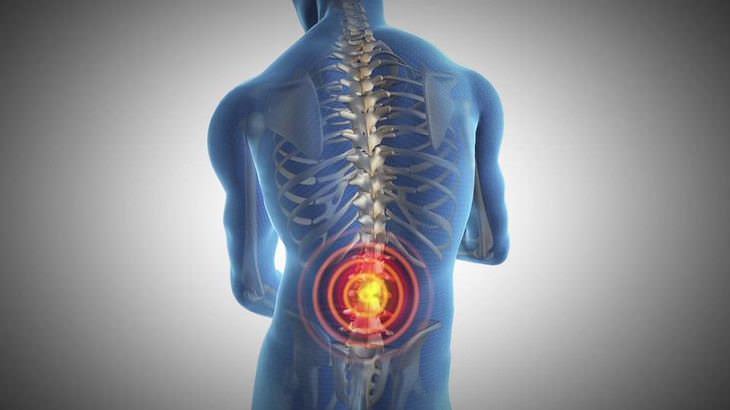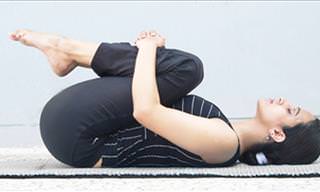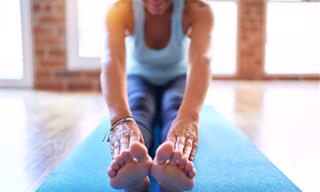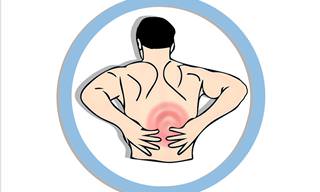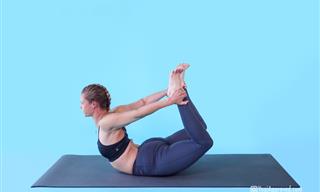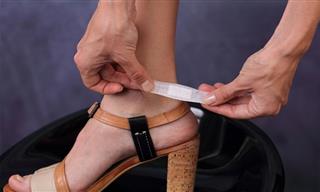1. Eccentric Straight Leg Raise
The straight leg raise works mainly on the hip muscles and strengthens the lower abdominal muscles. Regular repetition of this exercise during the week will help you improve posture and reduce the strain on your hips.
How to:
1. Lie on your back with your legs straight and your hands at your waist.
2. Tighten your abdominal muscles and lift your right leg to your chest area until you feel a slight stretch. While lifting, be sure to remove the air from your lungs and stabilize the opposite leg on the floor to provide your body with the necessary support.
3. After about 2-3 seconds, return to the starting position while inhaling, and then lift the opposite leg and repeat the same movement and breathing pattern.
4. The exercise can be repeated up to 10 times for each side.
2. Cat and Camel
Although we use our pelvic muscles during everyday life, their flexibility wanes over the years, resulting in frequent pain in the lower back. With the "Cat and Camel" exercise, you can gently stretch the area and extend the range of these muscles gradually and safely.
How to:
1. Crouch on the floor and keep your knees bent, your hands and back straight. It is recommended to perform the exercise on a soft surface, such as a carpet, to ease the load on the knees.
2. Take a deep breath and bend your head between your arms until you can see your knees. Bend your back as you move so that you feel a slight stretch in the center.
3. When the bending is over, exhale and return to the starting position. Keep your head straight so that your face is in a straight line with your back.
4. This exercise should be repeated 10 times in total.
3. Sit Backs
Many times, back pain occurs in the morning when getting up from bed or after sitting in a chair for a long time. In order to prevent the appearance of these pains and to reduce their intensity, it is recommended to perform the sit back exercise that strengthens the lower back and core muscles and helps improve overall posture.
How to:
1. Sit on a soft surface with your knees slightly bent, your back straight and your arms folded around your chest.
2. Imagine that behind you there is a backrest supporting your back, and slowly as you exhale, lean back and widen the bending of your knees to keep the starting position steady. It is recommended that you don’t strain your back too much, and if you feel that the exercise is upsetting your balance, try to reduce how far you're bending backward.
3. Take a deep breath, return to the starting position and perform the exercise 9 more times.
4. Bent Knee Raise
The bent knee raise is a simple exercise that can be performed even in bed which can prevent the imbalance created over the years between different muscle groups in the pelvis and lower back, which causes the recurrence of pain in these areas.
How to:
1. Lie on your back with your hands steady on the ground and your knees bent.
2. Squeeze your abdominal muscles, take a deep breath, exhale, and lift your knees up to your chest area. Be sure to lift one leg and then the other.
3. Stay in this position for 5 seconds and return your feet to the floor in the order opposite to lifting them.
4. The exercise should be repeated 10 times in total.
5. Hip flexion
The hip flexion exercise helps restore flexibility to the lower back muscles and the front thighs. The positive effects of this exercise can be felt in a wide variety of activities, such as lifting an object from the floor and hanging laundry that may have been an issue till now.
How to exercise:
1. Bend on the floor with your hands and knees firmly on the ground and your back upright.
2. Now, take a deep breath, exhale and bend your knees gradually so that your foot almost touches your buttocks. Be sure to keep your hands in place to create an effective stretch to the back.
3. This exercise should be repeated up to 10 consecutive times.
6. Bridging
Bridging works to strengthen the hip joint muscles located at the back of the thighs and buttocks and helps to reduce the load on the sacroiliac joint that connects the spine to the pelvis. In addition, this exercise stretches the spine and neck and improves posture.
How to:
1. Lie on a soft surface while keeping your back straight, your knees bent, and your hands steady on the ground.
2. Now, take a deep breath and exhale, then lift your buttocks into the air so that your hips and abdomen create a straight line, and wait in this position for approximately 3 seconds.
3. Return to the starting position and repeat the exercise 9 more times.
7. Leg Extensions
In addition to the bridging exercise, leg extensions also strengthen the core and buttock muscles and extend the range of motion and flexibility of the lower back area. The advantages of this exercise can be felt in a variety of daily activities that require sharp movements to the sides.
How to:
1. Get into a position where your palms and knees are placed on the floor. It is recommended to perform the exercise on a soft surface to avoid overloading the knees.
2. Now, lift one leg and straighten it as far as possible so that it creates a straight line with your back. Start the exercise with a deep inhale and exhale, making sure to maintain a stable posture.
3. Repeat this extension 10 times for each leg.
8. Curl Ups
This exercise is a milder and healthier version of classic sit-ups and will allow you to strengthen the core muscles in the abdomen almost without creating additional loads on the spine. The exercise is recommended to perform on a soft but not too soft a surface, such as a bed mattress, to maintain proper posture while performing it.
How to:
1. Lie on your back with your knees bent and your arms crossed on your chest area.
2. Squeeze your abdominal muscles, take a deep breath, exhale and lift your head along with your shoulders so you can see the ends of your knees.
3. Wait for 2-3 seconds, return to the starting position and repeat the exercise 9 more times.
9. Back Extension
Erector muscles are muscles located along the spine, which are responsible for our ability to straighten the back and maintain proper posture. In order to avoid the recurrence of back pain in general and in the lower back in particular, it is important to strengthen these muscles with a variety of different exercises, including back extensions.
How to:
1. Lie on your stomach with your hands spread out, preferably on a soft surface.
2. Take a deep breath, exhale, and with the support of your hands raise your torso so that only your lower abdomen remains on the ground.
3. Stay in this position for about 2 seconds, return to the starting position and repeat the exercise 9 more times.
10. Pelvic tilt
The pelvic tilt exercise is not made up of multiple movements, but its effect on the lower back area is great because it can strengthen the muscles of the buttocks, pelvic floor, and pelvis. In a short time, you will feel how the load on this part of the body is reduced and you’ll enjoy a greater range of movement in a variety of actions throughout your daily life.
How to exercise:
1. Lie on your back with your stomach slightly convex, your knees bent and your hands folded around your chest area.
2. Take a deep breath, contract your abdominal muscles, exhale and start pressing the lower back area against the surface on which you are lying.
3. Wait for 2-3 seconds, return to the starting position for another 2 seconds, and repeat the exercise again.
4. The exercise should be repeated 10 times in total.
source: vimeo
 Go to BabaMail
Go to BabaMail


